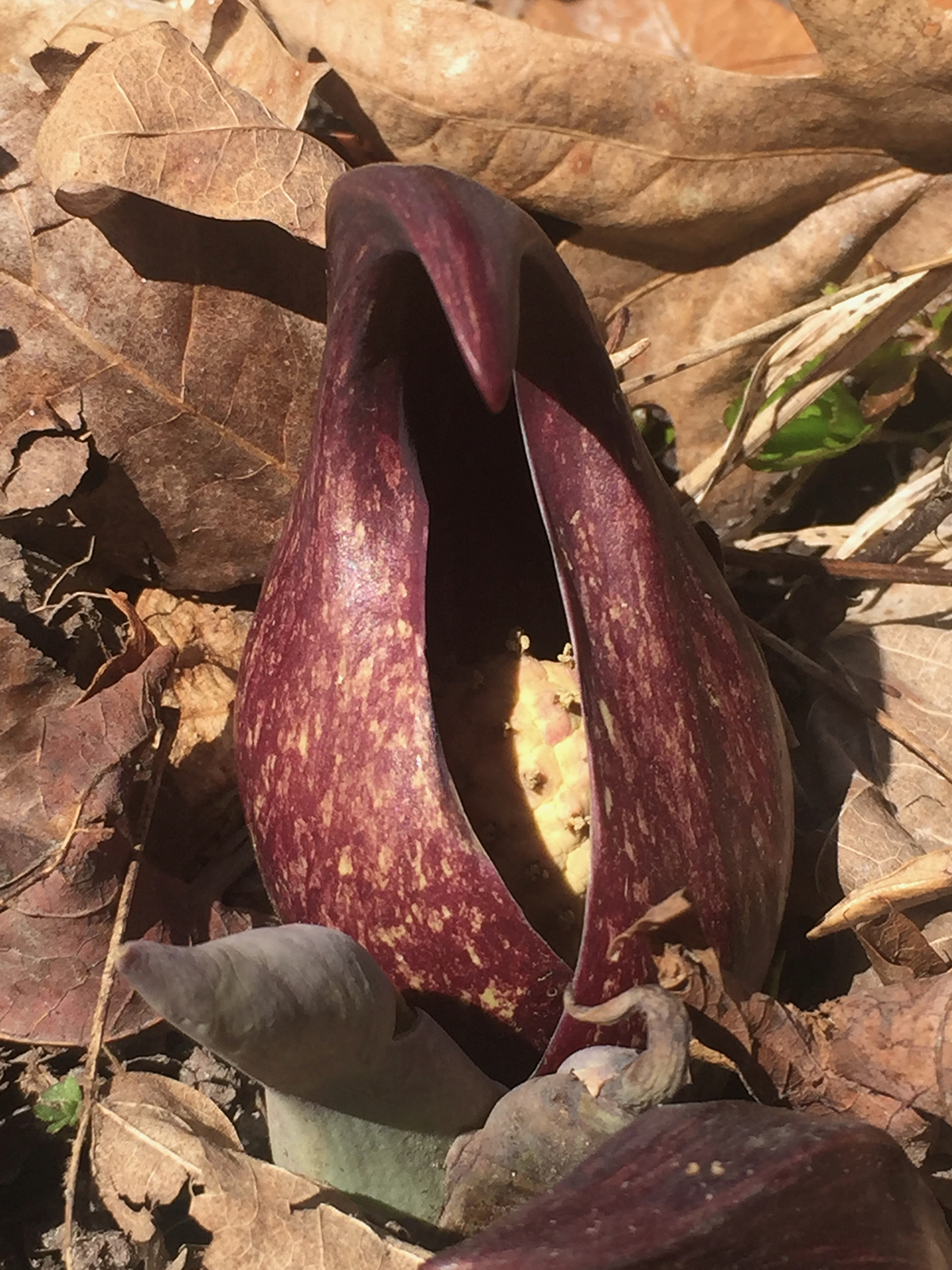March is one of those months that can seem to last forever. It can be a month where a waning winter reawakens, followed by a summer-like day of promise. From a weather perspective, it’s all over the place. The record cold temperature in March was -11 degrees F (3/8/1911) and the record warm is 87 degrees F (3/21/1907). That’s a possibility of close to 100 degrees of temperature swing. March lives up to the old saying of “in like a lion, out like a lamb.”
Those warm March days should be savored by everyone. It is a great opportunity to shake off the effects of winter and celebrate the coming of spring, which officially happens on March 20 this year. Nature reawakens in response to the lengthening days. March is an excellent time to partake in a wildflower pilgrimage to celebrate the changing of the seasons.

Skunk Cabbage in flower along the east end of Skunk Cabbage Trail in Singing Woods Nature Preserve, Peoria County.
PHOTO BY MIKE MILLER
One plant to seek out is the Eastern Skunk Cabbage (Symplocarpus foetidus). It is a plant in the Arum family and is related to Jack-in-the-Pulpit, Green Dragon, and Wild Calla. Like its relatives, the Skunk Cabbage has an interesting flower structure comprised of a curved spathe which surrounds a rounded spadix, which holds the actual flowers. Unlike its relatives that grow on graceful stalks accompanied by green leaves, the Skunk Cabbage grows squat to the ground, standing about 4 or 5 inches tall. This is an adaptation that helps it survive and bloom in fickle March weather. Not having leaves present to freeze in a snowstorm is advantageous.
Another unique adaptation for early season survival is the plant’s ability to produce heat. The Skunk Cabbage produces heat by metabolizing starch stored in its root system. Starch is translocated to the spathe and the plant utilizes oxygen to break the molecular bonds of the starch. This ability for plants to create heat is called thermogenesis. In the case of Skunk Cabbage, they can raise the temperature of the spathe up to 95 degrees F warmer than the surrounding air temperature. In other words, this plant could keep its flowers at a toasty 84 degrees F on a record setting cold day in March. The heat production ability of this plant allows it to warm the soil, melt ice, and begin growing. But that’s only part of the story of this odd wildflower.
It is called “Skunk” Cabbage for a reason. The odor of this plant has been described as a mix of death and rotting garlic. It is related to the infamous Titan Arum, or “Corpse Plant” and holds some of the same chemical traits as its stinky cousin. How is it an advantage to have stinky flowers? One only needs to look at what happens to a dead animal as it “ripens” to get their answer. Skunk Cabbage is pollinated by several species of flesh flies, corpse flies, and gnats. All of which are some of the earliest emerging insects in the spring. The chemistry of thermogenesis also lends itself well to the production of foul odor. Also important to the story is the habitat where the Skunk Cabbage grows. It is only found in wet, mucky soils located in alkaline seeps and springs. This is prime habitat for overwintering larvae of flies and gnats to emerge, especially if there is a plant with the ability to warm its surroundings above freezing temperatures.
By the end of March, the spathe of the Skunk Cabbage’s flowers will wither, and the spadix sets fruit and seeds drop into the mucky earth. Then the plant will produce a profusion of huge green leaves up to 20 inches long. These leaves are solar panels that will allow the root system to rebuild reserves of starch to fuel next year’s thermogenesis trick. Before autumn, the Skunk Cabbage has one more trick to ensure its survival. All this freezing, thawing, and wet soil can cause the roots to be heaved up in the mucky earth. There are several lateral roots tied to the main tuber of the plant. These lateral roots are “contractile” and can pull the top of the roots back underground in case they get too exposed.
If you want to make a pilgrimage in March to see Skunk Cabbage, you will have to seek out their habitat. Unfortunately, their habitat has become scarce in the modern landscape. In 1887, local botanist Frederick Brendel wrote that Skunk Cabbage was a common wildflower in the numerous springs and seeps at the base of bluffs along the Illinois River. Today, those springs and seeps are quite rare. In our immediate area, Bennett’s Terraqueous Gardens Nature Preserve in East Peoria, Spring Bay Fen Nature Preserve, south of Spring Bay, and Singing Woods Nature Preserve north of Peoria, are the few remaining natural populations of this incredible plant. Make sure you don’t get “skunked” this March on your wildflower pilgrimage and get out and find this intriguing wildflower.

